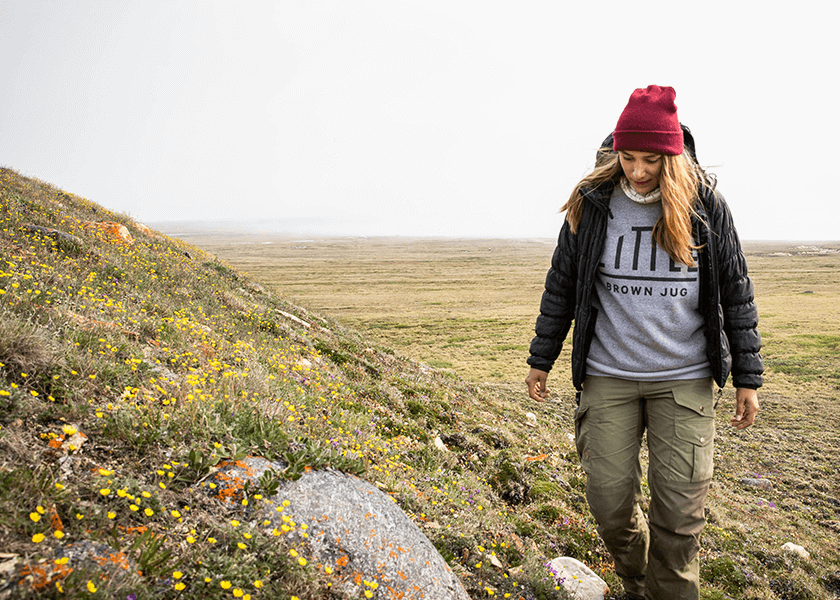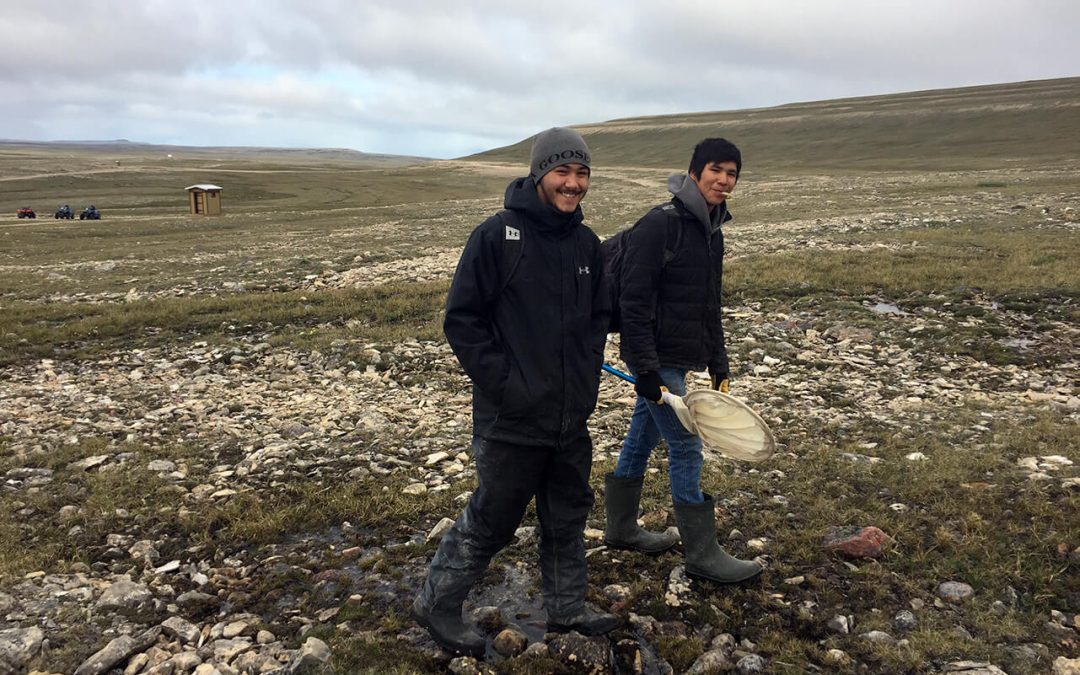
Arctic BIOSCAN: Tracking biodiversity in Canada’s Middle Arctic using DNA
Arctic BIOSCAN: Tracking biodiversity in Canada’s Middle Arctic using DNA
Danielle ‘Dani’ Nowosad wildflower hunting for the regional herbarium
Written by
DANIELLE NOWOSAD
The University of Guelph, Department of Integrative Biology
All photos credited to Dani unless specified otherwiseDNA barcoding is a molecular technique used globally to discover new species and assess biodiversity quickly and inexpensively. As it is based on standardized fragments of DNA, it can also be used to trace colonization patterns on Turtle Island (North America). My work is using DNA barcode data to quantify biodiversity and document colonization patterns in the Canadian Middle Arctic which would establish critical baseline data for future studies and enable us to monitor biological changes in response to climate change.
Cabin featuring the Nunavut flag on the shores of the Arctic Ocean.
DNA-based research in the Canadian Arctic
Seasonal camp in the Intensive Monitoring Area of Kilinoyak.
My research in the Iqaluktuttiaq (Cambridge Bay) region of Kilinoyak (Victoria Island), Nunavut, is in conjunction with the Arctic BIOSCAN (ARCBIO) project. ARCBIO, spearheaded by the Centre for Biodiversity Genomics (CBG) at the University of Guelph, aims to document all Arctic life using DNA barcodes—short pieces of DNA that are specific to each species. Funded by Polar Knowledge Canada (POLAR), ARCBIO is in its third year with at least four more years to go.
ARCBIO’s research base in Nunavut is in Iqaluktuttiaq (Ekaluktutiak or Ikaluktutiak, depending on who you’re talking with), a community of 1,600, located in Inuit Nunangat (the Inuit homeland). Iqaluktuttiaq also happens to be the site of the state-of-the-art Canadian High Arctic Research Station (CHARS) which opened its doors in August 2019.

Dani setting up a Malaise trap in front of the Canadian High Arctic Research Station (CHARS).
Located above the treeline on Kilinoyak’s southern edge, Iqaluktuttiaq is a polar desert with 24-hour daylight in the summertime. This region features stunning landscapes and prolific freshwater bodies of all sizes that are culturally, spiritually, and economically important to Inuit in this region. Many locals spend summer seasons fishing for Arctic char and trout, which use freshwater to spawn. Iqaluktuttiaq in the Inuinnaqtun dialect means “a good fishing place”. Arctic char has been harvested for generations for sustenance and now supports a local export industry.

Ice melting on the Arctic Ocean.
My research examines these water bodies and contributes an important resource to ARCBIO’s goals by establishing a DNA sequence catalogue of freshwater invertebrates for southern Kilinoyak. This will support future studies on biodiversity and allow us to monitor changes in freshwater ecosystems.
There is not enough local baseline data on biodiversity and abiotic variables such as water chemistry to track how climate change is altering the region. It is crucial to understand and mitigate changes to Arctic environments as these changes will have severe consequences globally including sea-level rise and unpredictable fluctuations in methane and carbon cycling1-3.

Dani collecting aquatic invertebrate samples on a helicopter trip near Wellington Bay.
Species found on Kilinoyak likely arrived within the last 7,500 years as the Laurentide ice sheet receded4. Some species might have managed to survive the last ice age in glacial refugia5, that is, regions largely in an ice-free state during the last ice age.
By analyzing the percentage of genetic divergence from local source populations, we can get closer to determining if this is the case. Taxa found in Iqaluktuttiaq that show a low percentage of genetic variance from taxa found elsewhere on Turtle Island could reveal interesting colonization patterns. For example, studies on small crustacean (Branchiopoda) in Churchill, Manitoba have shown multiple sources of origin from high Arctic regions in the north to Mexico in the south6. Apart from uncovering historical patterns, these data can inform models predicting the risk associated with invasive species to the region.
Dani assisting with a plant phenology/insect pollinator research project near CHARS.
The freshwater invertebrate catalogue currently consists of approximately 2,500 records from two summer sample collecting seasons. Most of these records include insects and crustacean (Arthropoda), of which many are flies (Diptera) and tiny water fleas (Anomopoda). Of these, just under 900 are of sufficient quality to obtain a standard DNA barcode. It is becoming clear with this early work that more sampling is needed to obtain a more comprehensive understanding of freshwater invertebrates in the Canadian Middle Arctic. Nevertheless, once sequences have been quality checked, researchers will release these data to the public via the standardized online DNA barcode library called BOLD.
BOLD—the Barcode of Life Data Systems—is an online, openly accessible repository for DNA sequence data and metadata. It allows users to create biogeographic maps, species accumulation curves, geo-distance correlations, biodiversity measures, and phylogenetic trees, among various other functions.
Haplotaxida
Daphniidae
Polyartemiella hazeni
Bosminidae
IMAGE CREDIT: CBG Imaging lab
My experience with BOLD and the DNA barcode pipeline began in the CBG’s Collections lab—a well-oiled machine where staff take gathered specimens, sort them, and input all their metadata (location, collection method, team members, etc.) into BOLD. Then, specimens are photographed, sent through automated DNA sequencing machinery, and finally, each sequence obtained is run through algorithms resulting in a BIN (Barcode Index Number) which is a proxy for species.

Fishing on the Arctic Ocean
With millions of records now accessible online, there is no question that DNA barcoding has contributed an incredible amount of knowledge and information to global biodiversity.
An important aspect and often interesting challenge in generating these data are sharing it in meaningful ways with local communities and the public.
Connecting the local community to DNA-based tools and technologies
View of the coast from Long Point
Committing resources and time to monitor environmental change in the Arctic is critical, but responsible research must prioritize integrating different voices from the community. As First Nations and Inuit communities in northern Canada7 are directly impacted, it is of the utmost importance to conduct this research in collaboration with local communities. This means listening to, including, and supporting Indigenous voices. Stitching together local Inuit’s experiences and traditional knowledge (otherwise known as IQ – Inuit qaujimajatuqangit) with climate change and scientific data in the region will only strengthen our understanding of these shared challenges and better position us to garner support for environmental protections.
ARCBIO offers several opportunities to fundamentally engage with local communities in ways that are not possible with one-off, short-term studies. As part of early sampling efforts, CBG hired two full-time Junior Science Rangers from the local community for the summer field season in 2019. This created summer jobs for local high school students who were paid for their expert knowledge of the land. Through working with CBG collections staff, they learned scientific methods for sampling invertebrates such as pitfall trapping, Malaise traps, plankton tows, and D-net sampling.
The CBG is also preparing a community report that will be released to locals this spring, just ahead of the 2021 field season. The community report will provide an overview of the ARCBIO project, its goals, and a description of DNA barcoding and methods used to assess biodiversity. It will be made available online through the ARCBIO website and social media.
Beyond these efforts, I have been exploring other ways to connect with the community. The pandemic has complicated in-person plans which had included a workshop held in conjunction with POLAR and the local high school, a knowledge-sharing wetland walk, and a freshwater-themed photo contest funded by POLAR.
Inukshuk with a view of town behind
Alternative outreach methods are being explored, taking into consideration the slower internet connectivity issues experienced by many Northerners. One possible method includes connecting with the local radio station that many locals tune into regularly to discuss research and generate conversations about science, increase awareness about projects, and put calls out for collaboration. The radio station communication strategy has been identified by locals in many northern communities as an excellent way to reach out8. Recently, a group of Inuit youth from various regions in Nunavut developed a concept they dubbed ScIQ (science + Inuit qaujimajatuqangit) in an effort to close the gap between attempts from external researchers to engage communities, and respectful inclusion8.

Monitoring equipment set up in the Intensive Monitoring Area, with Uvayuk (glacial esker) behind
One of the significant challenges ARCBIO will face is in finding ways to share barcode data with communities that are meaningful and useful. While data will be publicly available on BOLD, it is very likely that few, if any, locals will use the platform.
Sharing ARCBIO results with the local community in Cambridge Bay and other Northerners could be facilitated by a relatively new digital app called SIKU: the Indigenous Knowledge Sharing Network. This app was specifically designed by the Arctic Eider Society for Northerners. One might compare SIKU to iNaturalist, but specifically tailored for Northern hunters. It allows users to log ice and land conditions, animal sightings, hunting experiences, among other things in a privacy-protected space. App users can also submit plant and animal observations, including arthropod orders that are prolific across Northern Canada, such as caddisflies, mayflies, copepods, and beetles.

The SIKU mobile app and web platform by and for Inuit provides tools and services for ice safety, language preservation and weather. IMAGE CREDIT: siku.org
Part of the network is a “Projects” section, which lists various research initiatives such as government projects like Department of Fisheries and Oceans fish surveys, climate change studies, and other weather, climate, and wildlife-related studies. Principal Investigators can list a description of the project under this section as well as contact information and URLs. I believe this is a huge opportunity to communicate with the people who are most impacted and stand the most to gain by data that ARCBIO generates.
Unlike Facebook or any other mainstream social media platform, SIKU users can be assured that any information they share on the app remains their own. Due to these properties, SIKU may be a perfect avenue to share the ARCBIO project outcomes with local people who could benefit directly from the project’s data. I was first made aware of SIKU during the ArcticNet 2019 Annual Scientific Meeting, where the Arctic Eider Society did a public launch of the platform in a plenary session. Since the launch, Siku has gained popularity across Arctic Canada.
So far, our meetings with SIKU’s developers have explored the types of information that Northerners might find useful. Discussions have revolved around biogeographical figures, time series, and other such accumulations of data. Although this pipeline will require significant computational and technological power, I believe in years to come, it will result in user-generated research questions in which Southern researchers can assist locals in answering.
Moving Forward
Once the DNA barcode data is established, we as researchers must ask ourselves which information is relevant and important to locals. The public requires more than access to ARCBIO’s raw data. While ARCBIO is increasing barcode coverage for Arctic species, I believe that by developing a direct pipeline from BOLD to SIKU—with community consultation—ARCBIO can disseminate meaningful data for local benefit. Inuit have been explicit in their expectations for external researchers to approach science in the North with compassion, understanding of Northern cultures and lifestyles, respect, and inclusion. This doesn’t simply mean sending an academic publication of the results from a study to the community—it means developing relationships with community members, behaving in ways that are respectful to local culture, creating research questions with input from locals, and continuous communication throughout the study.
View of the last few pieces of ice before summer on the Arctic Ocean
Long-tailed jaeger
References:
1. Anisimov OA, Vaughan DG, Callaghan TV, Furgal C, Marchant H, Prowse TD, Vilhjálmsson H & Walsh JE (2007) Polar regions (Arctic and Antarctic). Climate Change 2007: Impacts, Adaptation and Vulnerability. Cambridge University Press, Cambridge, 653-685.
2. Prowse T, Bring A, Mård J & Carmack, E. (2015). Arctic freshwater synthesis: Introduction. Journal of Geophysical Research G: Biogeosciences, 120(11): 2121–2131. https://doi.org/10.1002/2015JG003127
3. Hammar J (1989) Freshwater ecosystems of polar regions: vulnerable resources. Ambio, 18(1): 6–22. https://doi.org/10.2307/4313520
4. Arthur D (2004) An outline of North American deglaciation with emphasis on central and northern Canada. Developments in Quaternary Sciences. 2. 10.1016/S1571-0866(04)80209-4.
5. Shafer AB, Cullingham CI, Cote SD & Coltman DW (2010) Of glaciers and refugia: a decade of study sheds new light on the phylogeography of northwestern North America. Molecular Ecology, 19(21): 4589-4621.
6. Jeffery NW, Elías-Gutiérrez M & Adamowicz SJ (2011) Species diversity and phylogeographical affinities of the Branchiopoda (crustacea) of Churchill, Manitoba, Canada. PLoS ONE, 6(5). https://doi.org/10.1371/journal.pone.0018364
7. Government of Canada; Indigenous and Northern Affairs Canada; Communications Branch. “Climate Change in Indigenous and Northern Communities.” Government of Canada; Indigenous and Northern Affairs Canada; Communications Branch, 19 Jan. 2021, rcaanc-cirnac.gc.ca/eng/1100100034249/1594735106676.
8. Pedersen C, Otokiak M, Koonoo I, Milton J, Maktar E, Anaviapik A, Milton M et al. (2020) ScIQ: an invitation and recommendations to combine science and Inuit Qaujimajatuqangit for meaningful engagement of Inuit communities in research. Arctic Science. 6(3): 326-339. https://doi.org/10.1139/as-2020-0015


















